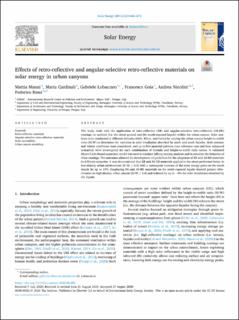| dc.contributor.author | Lobaccaro, Gabriele | |
| dc.contributor.author | Goia, Francesco | |
| dc.contributor.author | Manni, Mattia | |
| dc.contributor.author | Nicolini, Andrea | |
| dc.contributor.author | Rossi, Federico | |
| dc.contributor.author | cardinali, marta | |
| dc.date.accessioned | 2020-10-22T12:26:28Z | |
| dc.date.available | 2020-10-22T12:26:28Z | |
| dc.date.created | 2020-10-05T16:22:20Z | |
| dc.date.issued | 2020 | |
| dc.identifier.citation | Solar Energy. 2020, 209 662-673. | en_US |
| dc.identifier.issn | 0038-092X | |
| dc.identifier.uri | https://hdl.handle.net/11250/2684509 | |
| dc.description.abstract | The study deals with the application of retro-reflective (RR) and angular-selective retro-reflective (AS-RR) coatings on surfaces (i.e. the street ground and the south-exposed façade) within the urban canyon. Solar analyses were conducted at different latitudes (Oslo, Milan, and Cairo) by varying the urban canyon height-to-width ratio (H/W) to determine the variation in solar irradiation absorbed by north and south façades. Both summer and winter conditions were considered, and up to five material patterns (one reference case and four enhanced scenarios) were investigated for each combination of latitude and height-to-width ratio values. A validated Monte Carlo-based numerical model was used to conduct full-ray tracing analyses and to simulate the behavior of these coatings. The outcomes allowed the development of guidelines for the adoptions of RR and AS-RR materials in different scenarios. It was demonstrated that RR and AS-RR materials applied to the street performed better in low-density urban environment (H/W ≤ 0.5) with a consequent increase of the solar energy gains on the north façade by up to 15%. Employing RR and AS-RR materials on the south-exposed façade showed greater effectiveness on high-density urban canyon (H/W ≥ 2.0) and reduced by up to −8% the solar irradiation absorbed by the façade. | en_US |
| dc.language.iso | eng | en_US |
| dc.publisher | Elsevier | en_US |
| dc.relation.uri | https://www.sciencedirect.com/science/article/pii/S0038092X20309269 | |
| dc.rights | Navngivelse 4.0 Internasjonal | * |
| dc.rights.uri | http://creativecommons.org/licenses/by/4.0/deed.no | * |
| dc.subject | Solenergi | en_US |
| dc.subject | Solar energy | en_US |
| dc.title | Effects of retro-reflective and angular-selective retro-reflective materials on solar energy in urban canyons | en_US |
| dc.type | Peer reviewed | en_US |
| dc.type | Journal article | en_US |
| dc.description.version | publishedVersion | en_US |
| dc.subject.nsi | VDP::Bygningsfag: 530 | en_US |
| dc.subject.nsi | VDP::Building technology: 530 | en_US |
| dc.source.pagenumber | 662-673 | en_US |
| dc.source.volume | 209 | en_US |
| dc.source.journal | Solar Energy | en_US |
| dc.identifier.doi | 10.1016/j.solener.2020.08.085 | |
| dc.identifier.cristin | 1837265 | |
| dc.description.localcode | © 2020 The Authors. Published by Elsevier Ltd on behalf of International Solar Energy Society. This is an open access article under the CC BY license (http://creativecommons.org/licenses/by/4.0/) | en_US |
| cristin.ispublished | true | |
| cristin.fulltext | original | |
| cristin.qualitycode | 2 | |

